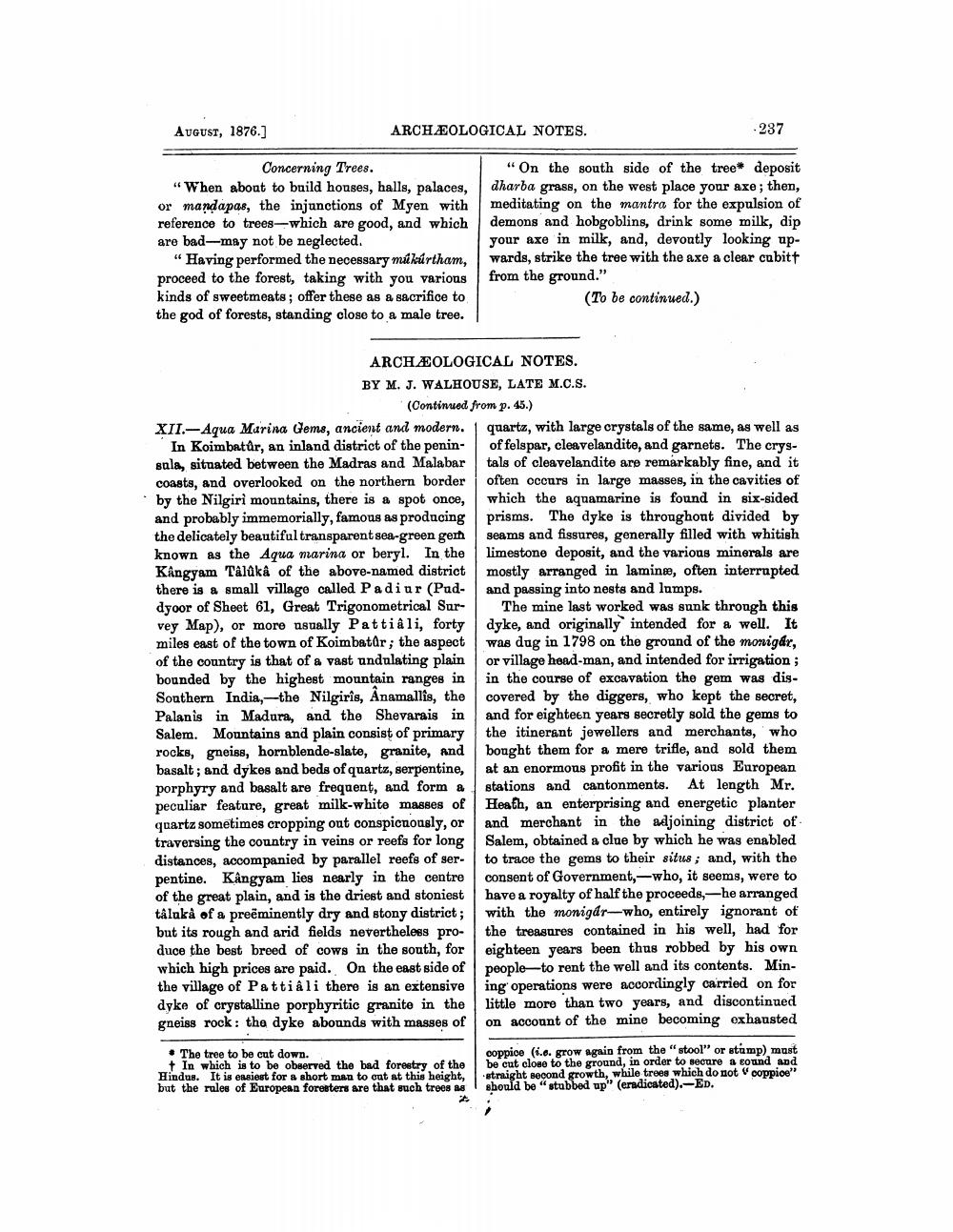________________
AUGUST, 1876.]
ARCHÆOLOGICAL NOTES.
237
Concerning Trees. "When about to build houses, halls, palaces, or mandapas, the injunctions of Myen with reference to trees--which are good, and which are bad-may not be neglected.
"Having performed the necessary má kúrtham, proceed to the forest, taking with you various kinds of sweetmeats; offer these as a sacrifice to the god of forests, standing close to a male tree.
"On the south side of the tree deposit dharba grass, on the west place your axe; then, meditating on the mantra for the expulsion of demons and hobgoblins, drink some milk, dip your axe in milk, and, devoutly looking upwards, strike the tree with the axe a clear cubitt from the ground."
(To be continued.)
ARCHÆOLOGICAL NOTES. BY M. J. WALHOUSE, LATE M.C.S.
(Continued from p. 45.) XII.-Aqua Marina Gems, ancient and modern. 1 quartz, with large crystals of the same, as well as
In Koimbatûr, an inland district of the penin- of felspar, cleavelandite, and garnets. The cryssala, situated between the Madras and Malabar tals of cleavelandite are remarkably fine, and it coasts, and overlooked on the northern border often occurs in large masses, in the cavities of by the Nilgiri mountains, there is a spot once, which the aquamarine is found in six-sided and probably immemorially, famous as producing prisms. The dyke is throughout divided by the delicately beautiful transparent sea-green gern seams and fissures, generally filled with whitish known as the Aqua marina or beryl. In the limestone deposit, and the various minerals are Kangyam Talaka of the above-named district mostly arranged in lamine, often interrupted there is a small village called Padiur (Pud- and passing into nests and lumps. dyoor of Sheet 61, Great Trigonometrical Sur- The mine last worked was sunk through this vey Map), or more usually Pattiali, forty dyke, and originally intended for a well. It miles east of the town of Koimbator; the aspect was dug in 1798 on the ground of the monigar, of the country is that of a vast undulating plain or village head-man, and intended for irrigation ; bounded by the highest mountain ranges in in the course of excavation the gem was disSouthern India, -the Nilgiris, Anamallis, the covered by the diggers, who kept the secret, Palanis in Madura, and the Shevarais in and for eighteen years secretly sold the gems to Salem. Mountains and plain consist of primary the itinerant jewellers and merchants, who rocks, gneiss, hornblende-slate, granite, and bought them for a mere trifle, and sold them basalt; and dykes and beds of quartz, serpentine, at an enormous profit in the various European porphyry and basalt are frequent, and form & stations and cantonments. At length Mr. peculiar feature, great milk-white masses of Heath, an enterprising and energetic planter quartz sometimes cropping out conspicuously, or and merchant in the adjoining district of traversing the country in veins or reefs for long Salem, obtained a clue by which he was enabled distances, accompanied by parallel reefs of ser
to trace the gems to their situs; and, with the pentine. Kangyam lies nearly in the centre consent of Government, -who, it seems, were to of the great plain, and is the driest and stoniest have a royalty of half the proceeds -he arranged talukå of a preēminently dry and stony district; with the monigdr-who, entirely ignorant of but its rough and arid fields nevertheless pro- the treasures contained in his well, had for duce the best broed of cows in the south, for eighteen years been thus robbed by his own which high prices are paid. On the east side of people to rent the well and its contents. Minthe village of Pattiâli there is an extensive ing operations were accordingly carried on for dyke of crystalline porphyritic granite in the little more than two years, and discontinued gneiss rock: tho dyke abounds with masses of on account of the mine becoming oxhausted
• The tree to be cut down.
In which is to be observed the bad forestry of the Hindus. It is ensiest for a short man to out at this height, but the rules of European foresters are that such trees as
coppioe (.e. grow again from the "stool" or stump) must be cut close to the ground, in order to secure sound and straight second growth, while trees which do not coppioe" should be "stubbed up" (eradicated).-ED.




